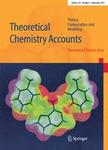版权所有:内蒙古大学图书馆 技术提供:维普资讯• 智图
内蒙古自治区呼和浩特市赛罕区大学西街235号 邮编: 010021

作者机构:Univ South Carolina Dept Chem & Biochem Columbia SC 29208 USA
出 版 物:《THEORETICAL CHEMISTRY ACCOUNTS》 (Theor. Chem. Acc.)
年 卷 期:2019年第138卷第1期
页 面:1-16页
核心收录:
学科分类:081704[工学-应用化学] 07[理学] 070304[理学-物理化学(含∶化学物理)] 08[工学] 0817[工学-化学工程与技术] 0703[理学-化学]
基 金:National Science Foundation [CHE-1565985] ASPIRE grant from the Office of the Vice President for Research at the University of South Carolina
主 题:Quantum dynamics Time-correlation functions Excited states Trajectory dynamics
摘 要:The quantum Hamilton-Jacobi equation (QHJE) is formally equivalent to the time-dependent Schrodinger equation, and the solutions to the QHJE can be easily interpreted in terms of trajectories providing a link between classical and quantum mechanics. The trajectory-based approaches to quantum molecular dynamics are, generally, appealing because they circumvent exponential scaling associated with exact quantum methods with the system size, and because, unlike classical molecular dynamics, such methods incorporate dominant quantum effects due to delocalization of wavefunctions describing the nuclei. We explore the utility of the QHJE framework for calculations of the time-correlation functions (TCFs) involving quantum evolution defined by the Boltzmann density operator and by the Hamiltonian time-evolution operator. The implementation is based on solutions to the imaginary-time counterpart to the QHJE, which yield approximations to the ground state wavefunction. The resulting nodeless wavefunction is used to generate a basis in coordinate space, which is efficient for evaluation of the low-lying excited states and of the quantum TCFs, including the Kubo-transformed TCFs, at low temperature. The QHJE/basis approach is illustrated on several model systems in and out of thermal equilibrium, i.e., the dimer and bound anharmonic potentials. If a system exhibits large amplitude motion, e.g., in case of the nonequilibrium dynamics, then the real-time trajectory propagation provides an alternative to the basis representation, as demonstrated on a model describing the inversion mode of the ammonia molecule and ion.